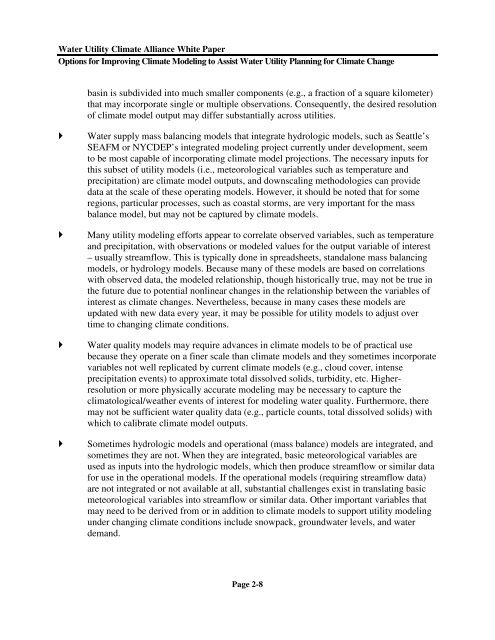Options for Improving Climate Modeling to Assist Water Utility ...
Options for Improving Climate Modeling to Assist Water Utility ...
Options for Improving Climate Modeling to Assist Water Utility ...
Create successful ePaper yourself
Turn your PDF publications into a flip-book with our unique Google optimized e-Paper software.
<strong>Water</strong> <strong>Utility</strong> <strong>Climate</strong> Alliance White Paper<br />
<strong>Options</strong> <strong>for</strong> <strong>Improving</strong> <strong>Climate</strong> <strong>Modeling</strong> <strong>to</strong> <strong>Assist</strong> <strong>Water</strong> <strong>Utility</strong> Planning <strong>for</strong> <strong>Climate</strong> Change<br />
basin is subdivided in<strong>to</strong> much smaller components (e.g., a fraction of a square kilometer)<br />
that may incorporate single or multiple observations. Consequently, the desired resolution<br />
of climate model output may differ substantially across utilities.<br />
<br />
<br />
<br />
<br />
<strong>Water</strong> supply mass balancing models that integrate hydrologic models, such as Seattle’s<br />
SEAFM or NYCDEP’s integrated modeling project currently under development, seem<br />
<strong>to</strong> be most capable of incorporating climate model projections. The necessary inputs <strong>for</strong><br />
this subset of utility models (i.e., meteorological variables such as temperature and<br />
precipitation) are climate model outputs, and downscaling methodologies can provide<br />
data at the scale of these operating models. However, it should be noted that <strong>for</strong> some<br />
regions, particular processes, such as coastal s<strong>to</strong>rms, are very important <strong>for</strong> the mass<br />
balance model, but may not be captured by climate models.<br />
Many utility modeling ef<strong>for</strong>ts appear <strong>to</strong> correlate observed variables, such as temperature<br />
and precipitation, with observations or modeled values <strong>for</strong> the output variable of interest<br />
– usually streamflow. This is typically done in spreadsheets, standalone mass balancing<br />
models, or hydrology models. Because many of these models are based on correlations<br />
with observed data, the modeled relationship, though his<strong>to</strong>rically true, may not be true in<br />
the future due <strong>to</strong> potential nonlinear changes in the relationship between the variables of<br />
interest as climate changes. Nevertheless, because in many cases these models are<br />
updated with new data every year, it may be possible <strong>for</strong> utility models <strong>to</strong> adjust over<br />
time <strong>to</strong> changing climate conditions.<br />
<strong>Water</strong> quality models may require advances in climate models <strong>to</strong> be of practical use<br />
because they operate on a finer scale than climate models and they sometimes incorporate<br />
variables not well replicated by current climate models (e.g., cloud cover, intense<br />
precipitation events) <strong>to</strong> approximate <strong>to</strong>tal dissolved solids, turbidity, etc. Higherresolution<br />
or more physically accurate modeling may be necessary <strong>to</strong> capture the<br />
clima<strong>to</strong>logical/weather events of interest <strong>for</strong> modeling water quality. Furthermore, there<br />
may not be sufficient water quality data (e.g., particle counts, <strong>to</strong>tal dissolved solids) with<br />
which <strong>to</strong> calibrate climate model outputs.<br />
Sometimes hydrologic models and operational (mass balance) models are integrated, and<br />
sometimes they are not. When they are integrated, basic meteorological variables are<br />
used as inputs in<strong>to</strong> the hydrologic models, which then produce streamflow or similar data<br />
<strong>for</strong> use in the operational models. If the operational models (requiring streamflow data)<br />
are not integrated or not available at all, substantial challenges exist in translating basic<br />
meteorological variables in<strong>to</strong> streamflow or similar data. Other important variables that<br />
may need <strong>to</strong> be derived from or in addition <strong>to</strong> climate models <strong>to</strong> support utility modeling<br />
under changing climate conditions include snowpack, groundwater levels, and water<br />
demand.<br />
Page 2-8

















